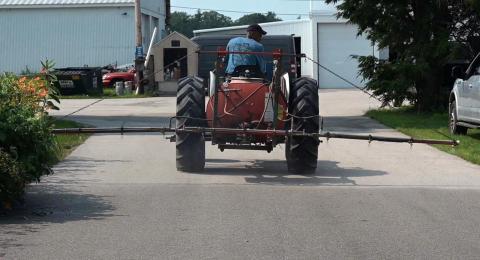Optimizing your boom sprayer’s distribution pattern is a key part of controlling pests on fruit and vegetable crops. This fact sheet outlines four methods for examining and optimizing spray patterns.
Before you Start
First, calibrate your sprayer. Before you evaluate and adjust spray distribution, calibrate your sprayer so you know you are applying the correct amount of material. Follow the steps outlined in the Boom Sprayer Calibration worksheets.
Set Up Your Sprayer
Check your sprayer and all its components to be sure it is set up correctly. make sure that:
- The pressure is correct
- Nozzles are set at the correct height for your crop
- Distances between nozzles are correct
- Nozzles are not plugged
Test your sprayer using the same settings you will use when treating crops. The sprayer should be at the same speed (RPM, gear and throttle setting) that you will use later. Put water in the sprayer tank when testing.
Spray Pattern Options
There are four different methods that can be used to examine and optimize the spray pattern:
- Visualize the Pattern
You may be able to visualize the pattern by spraying a dry farm roadway (dirt or paved) or a long, flat patch of concrete. If gaps or heavy patches show up, make adjustments. It is difficult to quantify differences using this method, but it is quick and simple. - Water Sensitive Cards
Distribute water-sensitive cards throughout the target canopy. These cards are available at most agricultural sprayer dealerships. These yellow cards turn blue wherever a drop of water or oil touches them. As long as coverage doesn’t exceed 30%, drops can be counted to quantify spray coverage. Because they are artificial targets, card orientation and distribution in a target canopy is critical to ensure they accurately reflect coverage. Highlight their location using flagging tape, and staple or clothespin them in place. Once dry, they can be collected and replaced in order to compare sprayer passes. They are relatively cheap and convenient for either prolonged coverage trials or running a quick double-check during an application. - Kaolin-based Sprays or Dye
Put a registered, food-grade kaolin-based product (e.g. Surround) or UV dye in the tank and spray your test plants with the same sprayer settings, and in the same weather conditions, as you normally would. Because the spray lands on the crop itself, this qualitative method quickly reveals gaps, or excessive coverage. However, the operator does not have the opportunity to change a sprayer setting and make a second pass on the same target to compare coverage. Further, UV sprays will likely require night-spraying and the use of UV lights to examine the results. -
Patternators
To use a horizontal patternator designed for boom sprayers, place the patternator on the ground under the boom. Spray for 30 seconds to one minute, then tip up the patternator to see the amount of spray delivered to each cell. It is quick and easy to see the spray distribution.
Recording Your Results
Maintaining accurate records is essential to the optimization process. Once you have adjusted your sprayer to the correct pattern, write down the settings (along with the date and time of testing) so that you can use the optimized settings in the future. This is especially helpful if something is lost or your sprayer is repaired.
Visit https://sprayers101.com/ for more information on assessing spray coverage.
The information in this document has been funded wholly or in part by the US EPA Region 1 to the New England Vegetable & Berry Growers’ Association; it may not necessarily reflect the views of the Agency and no official endorsement should be inferred. Mention of trade names or commercial products does not constitute endorsement or recommendation of use.
Additional Resources
- Boom Sprayer Calibration Worksheet - 1/128th Method
- Boom Sprayers - One-Minute Method of Calibration
- Boom Sprayer Calibration Worksheet - One-Minute Method
- Boom Weed Sprayer Calibration Worksheet - One-Minute Method
About the Author
George Hamilton is a retired UNH Cooperative Extension Field Specialist in agriculture dealing with fruit and vegetable production. Fact sheet updated November 2023.
ACKNOWLEDGEMENTS
Thank you to Dr. Jason Deveau, Application Technology Specialist, OMAFRA, Simcoe, Ontario and Dr. Alan T. Eaton, retired Extension Specialist in Entomology and professor, emertius at the University of New Hampshire, for reviewing the original manuscript.
UNH EXTENSION'S FOOD AND AGRICULTURE PROGRAM
As a component of Extension's Food & Agriculture Program, Extension specialists provide educational resources, training programs, and direct technical assistance for private and commercial pesticide applicators.
Extension Services & Tools That Help NH Farmers Grow
Newsletters: Choose from our many newsletters for production agriculture
Receive Pest Text Alerts - Text UNHIPM to (866) 645-7010


